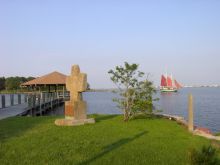
Few names in American history awaken echoes as "Roanoke" does. Roanoke Island ... this is where, four centuries ago, the curtain began to rise on English colonization in the Americas ... then dropped, never to lift again for that brave, small first colony.
What happened to them? Where did they go and why? To understand it all, to see the significance of this small, still-forested island, we'll have to go back – all the way to the 1580s.
In those days Spain, not England, ruled the waves, and the treasure lands in the New World as well. The Conquistadors had devastated South American Indian empires in their lust for gold. But they had left North America untouched, except for a settlement at St. Augustine, Florida. The French, too, were active, trying (and failing) to establish colonies in present-day Canada and South Carolina.
England was not in those days the daring seafaring nation she later became, but interest in the new lands was slowly building, fanned by Elizabeth's refusal to bow before Spanish might. It was Humphrey Gilbert, Sir Walter Raleigh's half-brother, who first advocated actual colonization of America, both as an advanced base for operations against the Spanish and to settle " ... needie people of our Countrie, which now trouble the common wealth." Gilbert himself was lost on an expedition in 1583, but Raleigh caught the fever for colonization from him.
And fever it was. Raleigh, almost alone among his contemporaries, seemed to have some idea of the possibilities this vast, temperate, fertile land held for permanent settlers, and he was determined that they should be, not Spanish or French, but English.
In 1584 Raleigh dispatched his first exploring expedition. On July fourth – a date later to be commemorated throughout the land, but for different reasons – Captains Arthur Barlowe and Philip Amadas arrived off the Banks and began their explorations. They landed north of Kitty Hawk to take formal possession and were astounded at the profusion of cedar, deer, wildfowl and wild grapes. They met the local Indians, who had a village on the northwest end of Roanoke Island, and found them friendly. They left after a month, taking along two Indians named Manteo and Wanchese, and their reports caused a stir in England. In fact, by the very next spring, Raleigh had outfitted seven ships and 600 men, getting them to sea in April. Again, Raleigh himself could not go; Elizabeth wanted him in England in case of Spanish attack. Sir Richard Grenville was placed in charge of the fleet, with Ralph Lane as lieutenant governor.
Grenville had a little trouble at Ocracoke Inlet – his flagship Tiger went aground and was almost lost – but he freed and floated her and pushed on into the sound.
He took a week to explore the mainland within the sounds. The English visited several Indian villages and were well received at most. After a visit to one, however, Aquascococke, Grenville found himself missing a silver cup (it is possible there was a misunderstanding about an exchange of gifts). Unable to regain it, he had his men burn the town, then proceeded on his explorations.
At last he pushed on up the sound, to Roanoke, and after some time decided that this would be the site for the first settlement.
Why did Grenville and Lane choose Roanoke? There were better sites for a colony already known – the Chesapeake Bay area, farther north, had much better soil, deep rivers and better harbors. They may have chosen Roanoke because it was inaccessible to large ships –Spanish ships. Or it may have been a simple miscalculation.
The 600 men spent the summer building a small earthwork fort, Fort Raleigh, and a few houses. In August Grenville sailed with his ships, leaving “Governor” Lane in charge of 107 men.
The winter was not easy, but more ominous than the weather was the worsening of relations with the Indians. Lane and some of his men explored up the rivers of the Albemarle, following rumors of cities of gold, but their methods of obtaining food and information quickly turned the inhabitants against them. When he returned, the governor, alleging conspiracy, then led an attack on the village of the Roanoke weroance (king) Wingina, killing the chief and his advisors. Afterward he tried to set up Manteo, who remained pro-English to the end, but it was evident that the English and Indians were beginning to regard each other as enemies.
Perhaps that was why, when Grenville was late in returning, Lane decided to pull out when Sir Francis Drake stopped by in the spring. Grenville’s relief fleet arrived just a few weeks later and he was surprised to find the island deserted. Unwilling to abandon the fort, he left 15 soldiers there to winter over before sailing again for home.
High dreams were dreamed that winter of 1586-87 in England, for Raleigh was pulling together, at long last, his colonizing expedition. Led by John White, three ships left Plymouth, carrying 120 men, women, and children.
The first mystery met them when they landed. The 15 men Grenville had left were gone; only one skeleton was found, moldering beside the demolished fort.
The new colonists shook their heads, doubtless prayed, but pitched in to clear land and build homes, guarding always against the hostile and shadowy figures in the forest. On August 18 a child was born, Virginia Dare, the first English child born in the New World (though let us not forget that the Spanish had been around, farther south, for almost a century). Governor White, her grandfather, left with the autumn for England to organize more supplies and colonists.
But war intervened, war with Spain, and, with Philip's Armada menacing England, Elizabeth had no ships to spare for Raleigh's dream colonies. It was not till 1590 that White was able to return, and when at last he landed again on Roanoke, the village had been evacuated, and the colonists had gone – where? On trees nearby were carved the words: CROATOAN; CRO. But on Croatan Island no traces have ever been found.
What happened to the Lost Colony?
Paul Green, in the last scene of his historical drama of the same name, suggests that they abandoned Roanoke because of a Spanish threat, hoping to stay with friendly Indians of Manteo's tribe. As to what happened after that, many theories have been advance over the years. One, widely believed early in this century was that the main body found friendly Indians at Croatan Island (now part of Hatteras), intermarried with them as they wandered about North Carolina, and survived until modem times in the English surnames and blue eyes of the Lumbee Indians of Robeson County. Some scholars believe that the main body went north rather than south, arriving safely at the southern coast of the Chesapeake Bay. They lived with the Indians there peacefully, but were massacred by Powhatan when the Jamestown expedition arrived in 1607. No one at this point knows for sure.
Roanoke was left to the Indians for a long time after, but eventually, circa 1655, the press of whites southward out of Tidewater Virginia reached the Northern Banks, and families still seen today on the island – names like Gallop, Baum, Meekins, Tillet, Daniels and Midgett – settled down to stay. The small population was supported by stock raising and small-scale farming through the 17th and 18th centuries.
The Civil War began the process of the island's awakening with a cannonade. At 10:30 a.m., February 7, 1862, a gigantic shallow-draft Federal fleet, with 12,000 troops aboard, began a bombardment of Confederate shore batteries on the northern end of the island (an overlook at Northwest Point today commemorates this battle). That evening 7,500 Federals disembarked at Ashby's Landing (now Skyco ). The next morning they moved north, opposed bitterly every step of the way up the island, till a final charge routed the Rebels, who surrendered. The war was marked also by the quartering, on the northern end of the island (west of where the Elizabethan Inn now stands) of some 3,000 newly freed slaves, most of whom were relocated off the island when the war ended.
As population increased after 1865, homes clustered around the two harbors at Shallowbag Bay and at Mill Landing. These were referred to respectively as the Upper End and Lower End of the island. Around 1886 the Lower Enders grew understandably tired of being called that and chose the name of Wanchese for their town; Manteo followed suit, incorporating in 1899, shortly after being named seat of newly formed Dare County. Since then both towns have grown slowly but steadily.
Milestones followed:
In 1902 Reginald Fessenden, a pioneer in the development of radio, transmitted signals from an apparatus on Roanoke Island to one on Hatteras. In 1900-1903, the brothers Wright took a ship from Roanoke for Kitty Hawk.
In 1928 a privately constructed bridge first connected Roanoke Island with the beach community of Nags Head, opening the outer islands to development.
In 1937 Paul Green’s outdoor drama The Lost Colony was performed for the first time. It is still running every summer, and celebrated its 80th year in 2017.
After World War II, the stabilization of the Banks and the construction of roads and bridges, along with the creation of the National Parks in the area, brought modern tourism and real-estate development to the island.
Today Roanoke Island has two characters. For much of the year it ls a quiet, low-key area, where most of the nearly 7,000 residents know one another by name. All this begins to change round about May, when the golden tide of tourists begins; and the months of summer are full of activity, especially at the North Carolina Aquarium on Roanoke Island and The Lost Colony and in the shops and restaurants of downtown Manteo and along Highway 64/264.
The people are friendly and beauty still lies on the land during the long humming evenings of summer. As Amadas and Barlowe found in 1584, this might still be said to be " ... the goodliest land under the cope of heaven."






